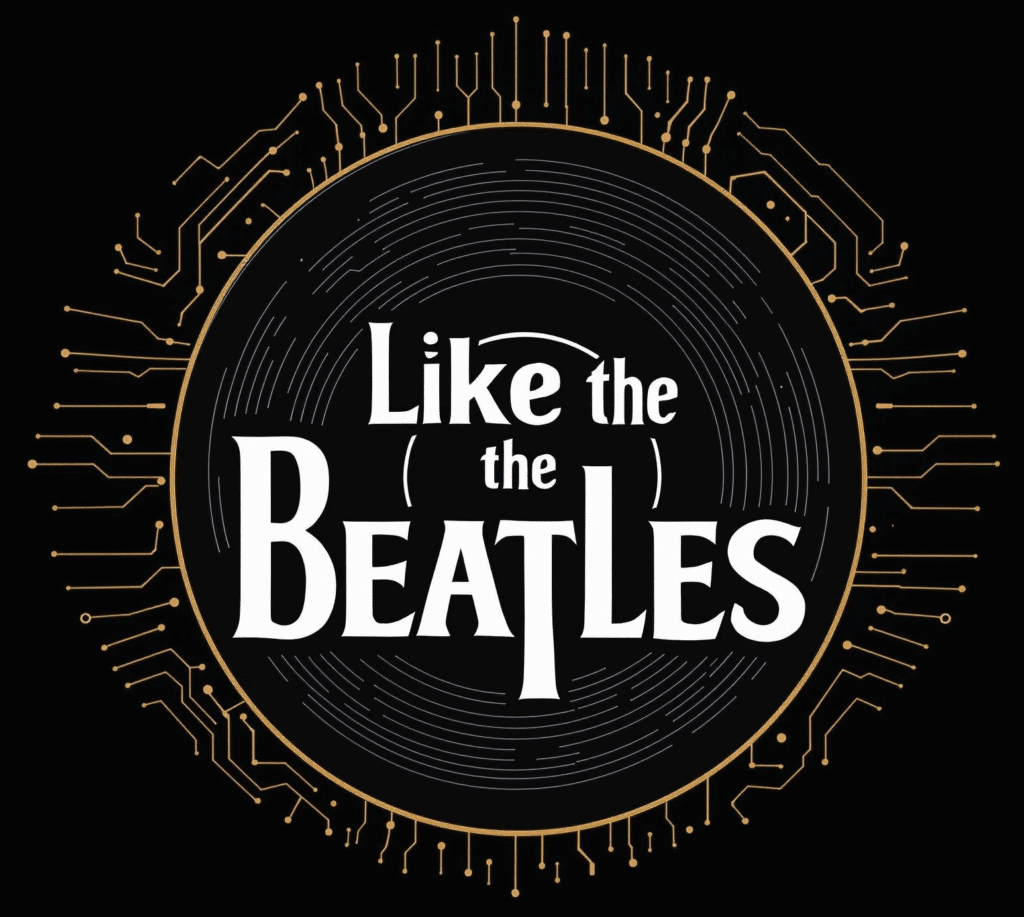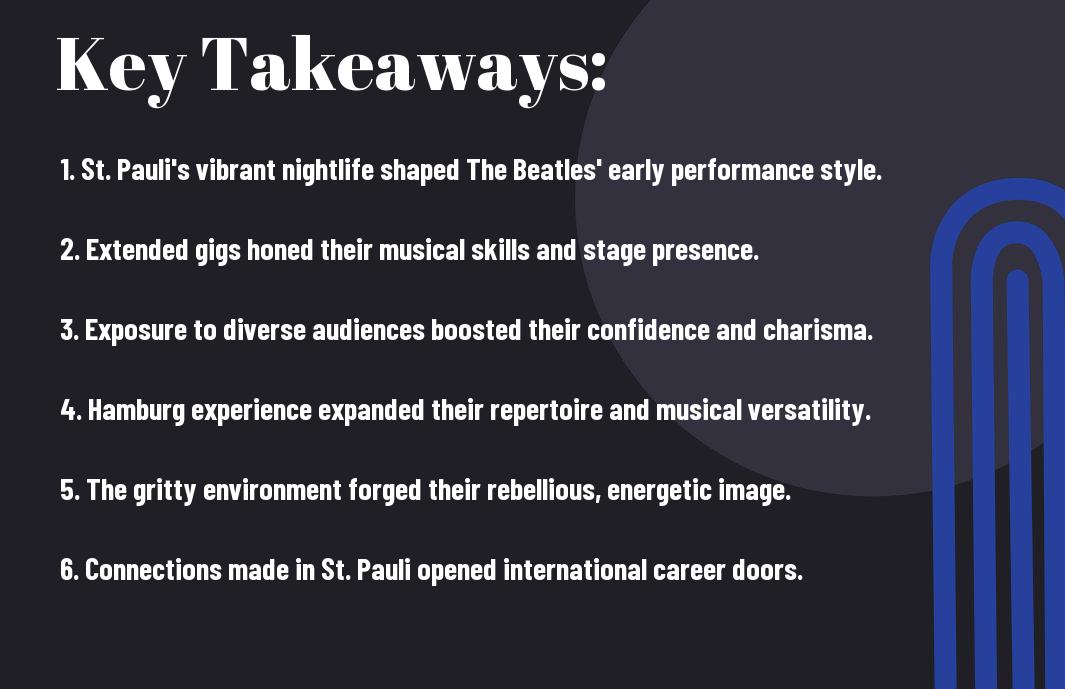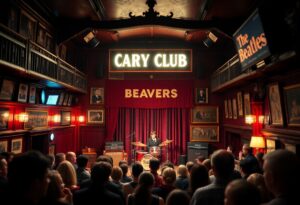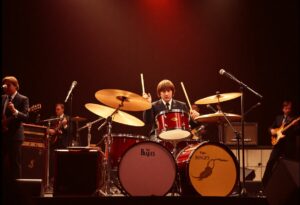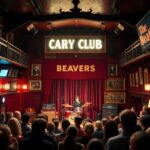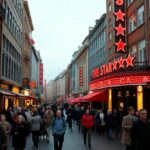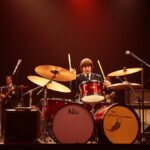Most music enthusiasts know that Hamburg’s St. Pauli played a transformative role in shaping The Beatles, but its impact goes beyond mere performance venues. As I investigate into this gritty yet vibrant neighborhood, I’ll unveil how the rough-and-tumble nightlife and eclectic scene introduced the band to a world of unrestrained creativity and toughened them for future success. From their early gigs to the cultural influences that seeped into their albums, you’ll see how St. Pauli became a foundational chapter in The Beatles’ legendary story.
The Early Years of The Beatles in Hamburg
A big part of The Beatles’ journey began in Hamburg, where they honed their musical skills in the vibrant and chaotic nightlife of the city. This experience shaped their style and performance abilities, setting the stage for their explosion onto the global music scene. Hamburg was more than just a backdrop; it became a training ground that tested their resilience and creativity, as they played countless gigs in various clubs, gaining invaluable experience that would define their future.
The Role of St. Pauli
Among the many districts in Hamburg, St. Pauli was a significant influence, known for its lively atmosphere, nightlife, and artistic scene. This neighborhood was home to the infamous Reeperbahn, where The Beatles performed and mingled with the local culture. The gritty yet vibrant environment of St. Pauli encouraged the band to push boundaries and explore new musical ideas, heavily shaping their artistic development during these formative years.
First Performances and Experiences
Performances in Hamburg were a whirlwind of excitement and challenges for The Beatles. They faced various situations, from long nights in smoky clubs to dealing with an occasionally unruly crowd. These gigs were not just performances; they were lessons in endurance and adaptability. From the very first show at the Indra Club to later sets at the Kaiserkeller, each experience contributed to their tightness as a band and their understanding of audience engagement.
Experiences like these were instrumental in teaching The Beatles how to captivate an audience. They played numerous long sets, sometimes lasting for hours, which helped them build stamina and improve their musicality. The environment was often intense and unpredictable; they encountered rowdy patrons and challenging moments that tested their composure. Yet, these factors only fueled their passion for performing. The camaraderie developed within the band, alongside the sheer thrill of performing every night, created an atmosphere ripe for artistic growth and innovation.
The Music Scene in St. Pauli
It was in the lively streets of St. Pauli that the seeds of The Beatles’ musical journey were sown. The area was a vibrant hub, brimming with diverse sounds and talent, making it an influential backdrop for the band’s early development. For those interested in exploring this fascinating connection further, I recommend checking out A Magical Mystery Tour of the Beatles’ Hamburg.
Clubs and Venues
Below the surface, St. Pauli was home to numerous clubs and venues that played a pivotal role in shaping the music scene during The Beatles’ formative years. Places like the Indra Club and the Kaiserkeller provided much-needed exposure, allowing the band to refine their skills and captivate audiences, leading to significant early performances that fueled their ambition.
Influence of German Rock and Roll
One cannot underestimate the impact of German rock and roll on The Beatles as they honed their craft in St. Pauli. The British quartet was surrounded by the energy and spirit of local rock acts, which inspired them to push boundaries in their music. Clubs like the Bambi Kino showcased this vibrant scene, where I can imagine the electrifying atmosphere that inspired not only The Beatles but countless artists after them.
Clubs in St. Pauli were where the raw energy of German rock and roll collided with The Beatles’ burgeoning sound. The fusion of local talent, gritty settings, and eager fans provided the band with an exhilarating environment to perform and evolve. This atmosphere stirred their creativity and taught them the importance of connecting with their audience, laying the foundation for their later, world-famous performances. The influence of this scene is evident as I analyze their growth from a local band to global icons.
Cultural Exchange and Artistic Growth
Once again, the vibrant atmosphere of St. Pauli played a significant role in shaping The Beatles’ artistry. The district’s diverse cultural landscape provided the band with a wealth of experiences and influences that enriched their music. The interaction with various artistic movements and the acceptance of different musical styles fostered a spirit of experimentation in The Beatles, allowing them to grow continually throughout their career.
Interaction with Local Musicians
Against the backdrop of St. Pauli’s lively music scene, The Beatles engaged with local musicians, immersing themselves in the unique sounds of Germany. This collaboration encouraged them to explore different genres and styles, broadening their musical horizons and enhancing their creativity.
Development of Their Unique Sound
After countless nights spent performing in the clubs of St. Pauli, The Beatles began to refine their sound, blending rock ‘n’ roll with elements of rhythm and blues, all influenced by their experiences on the Reeperbahn.
Local bands and artists showcased a raw, energetic vibe that ignited The Beatles’ passion for innovation. They experimented with various instruments, vocal harmonies, and songwriting techniques that would define their iconic sound. The gritty atmosphere of St. Pauli pushed them to create boldly, and this blend of influences ultimately led to music that resonated globally. As they honed their craft, their songs became a beautiful mix of emotion and technical skill, making them pioneers in the evolving music scene. This foundation, laid in St. Pauli, set the stage for their extraordinary journey.
The Legacy of St. Pauli on The Beatles
After experiencing the vibrant nightlife and diverse culture of St. Pauli, The Beatles left an indelible mark on their music and persona. The unique atmosphere of Hamburg shaped their work ethic, creativity, and stage presence, which they carried throughout their careers. This legacy is a testament to how the neighborhood not only influenced their early years but echoed through their journey as some of the world’s most iconic musicians.
Lasting Memories and Stories
Along their journey, The Beatles collected countless stories that emerged from their time in St. Pauli. The late nights spent performing in small clubs, the friendships forged with fellow musicians, and the challenges they faced all contributed to a rich tapestry of experiences. These lasting memories helped to define their identities and, ultimately, their artistry.
Impact on Their Later Career
Beatles’ time in St. Pauli instilled a fearless approach to performing and songwriting that resonated in their later career. The vibrant environment and diverse musical influences they absorbed became an integral part of their sound, which continually evolved over time. The raw energy and spontaneity they experienced helped them embrace experimentation and authenticity in their music.
Lasting exposure to the boisterous nightlife and diversity of St. Pauli equipped The Beatles with a unique cultural lens. Their time in Hamburg fostered a sense of resilience and innovation that propelled their evolution into the legends we know today. As they transitioned from local performers to global icons, the bold spirit of St. Pauli remained a guiding force in their creativity, influencing their experimentation with genres and styles that continuously shaped popular music.
St. Pauli in Beatles’ Lyrics and Imagery
All throughout their career, The Beatles incorporated elements from their time in St. Pauli into their music, painting a vivid picture of the nightlife and culture that surrounded them. The energy and vibrancy of the district became a backdrop, influencing themes of love, rebellion, and the complexities of life. This connection can be traced from their early songs to their later works, demonstrating how the spirit of St. Pauli resonated in their creativity.
Direct References
Above all, The Beatles made explicit references to St. Pauli in several tracks, encapsulating the essence of their experiences. Songs like “Love Me Do” and “You’ve Got to Hide Your Love Away” contain lyrics that echo the nostalgic feelings tied to their time in the bustling nightlife of the Reeperbahn. These references offer a glimpse into how the district shaped their artistic expressions in their formative years and beyond.
Symbolism and Inspirations
Across their body of work, The Beatles infused their lyrics with symbolism drawn from the vibrant life of St. Pauli. The lively nightlife, the spirit of freedom, and the world of the zaftig fascination permeate their music, symbolizing themes of individualism and collective joy. The characters you encounter within their songs often reflect the eclectic mix of people that made up the St. Pauli community. Inspirations from the energy of the Reeperbahn, the freedom to explore life’s pleasures, and the risks associated with such a lifestyle provided a rich tapestry for their songwriting. As listeners, we can peel back the layers of their lyrics to discover the textured influences of this vibrant district, revealing how it shaped their personal and artistic journey.
To wrap up
Presently, I recognize that Hamburg’s St. Pauli district played an undeniable role in shaping The Beatles’ musical journey. From honing their performance skills in the infamous clubs to soaking up diverse influences, your understanding of their evolution is enriched by St. Pauli’s vibrant atmosphere. You can trace their growth from ambitious young musicians to global icons, all influenced by the experiences and challenges they faced during their time in this dynamic neighborhood. Ultimately, St. Pauli was not just a backdrop but a defining chapter in their story, key to their legendary status.
